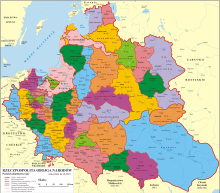Sieradz Voivodeship (1339–1793)
| Sieradz Voivodeship Palatinatus Siradiensis Województwo sieradzkie | |||||
| Voivodeship of Poland¹ | |||||
| |||||
|
Coat of arms | |||||
 the Polish–Lithuanian Commonwealth in 1635. | |||||
| Capital | Sieradz | ||||
| History | |||||
| • | Established | 1339 | |||
| • | Second partition | 25 September 1793 | |||
| Area | 9,700 km2 (3,745 sq mi) | ||||
| Political subdivisions | counties: four, plus two counties of Wieluń Land | ||||
| ¹ Voivodeship of the Kingdom of Poland. The kingdom was part of the Polish–Lithuanian Commonwealth from 1569. | |||||
Sieradz Voivodeship was a unit of administrative division and local government in the Kingdom of Poland and the Polish–Lithuanian Commonwealth, from 1339 to the second partition of Poland in 1793. It was a part of the Province of Greater Poland.
Its total area was 9,700 km2, divided into four counties. The seat of the voivode was in Sieradz, while local sejmiks took place in Szadek.
The history of Sieradz Voivodeship dates back to the year 1138, when following the Testament of Bolesław III Krzywousty, Poland was divided into several smaller duchies. One of them was the Duchy of Sieradz, which until the 1260s was part of the Duchy of Łęczyca. In 1290–1300, and after 1306, Sieradz was ruled by Duke Wladyslaw Lokietek, who incorporated it back into the Kingdom of Poland. In 1339, Wladyslaw Lokietek created Sieradz Voivodeship out of the former Duchy. In the west, it bordered Kalisz Voivodeship and the Duchies of Silesia; in the north, along the Ner river, it bordered Łęczyca Voivodeship; in the east it bordered Sandomierz Voivodeship along the Pilica river from Koniecpol to Białobrzegi; and in the south it bordered Kraków Voivodeship, partly along the Liswarta river.
The voivodeship had the area of 162 sq. miles, with four counties. When in 1396 the Wieluń Land returned to Poland, it became part of Sieradz Voivodeship, which increased the number of counties to six. In the mid-16th century, the voivodeship (without the Land of Wieluń) had 127 Roman Catholic parishes, 29 towns and 938 villages, while the Land of Wieluń had 67 parishes, 13 towns and 182 villages. Sieradz Voivodeship had five senators: the Voivode of Sieradz, the Castellan of Sieradz, and the Castellans of Rozprza, Spycimierz and Konary. Main starostas resided in Sieradz and Piotrków Trybunalski, there also were starostas at Radomsko, Szadek, Tuszyn, Klonowa, Warta and other locations. The sejmiks at Szadek elected four deputies to the Sejm, and two deputies to the Greater Poland Tribunal in Piotrków Trybunalski.
Wieluń Land, with the area of 50 square miles, had its own administrative system and a senator, who was the Castellan of Wieluń. It also had its own starostas, residing at Wieluń, Ostrzeszów, Grabow nad Prosna, and Bolesławiec, and elected two deputies to the Sejm, at the separate sejmiks in Wieluń. Furthermore, the Voivode of Sieradz named his deputy, who ruled the Land of Wieluń.
Governor seat:
Voivodes:
- Kasper Doenhoff (1634–1645)
Administrative division:
- Sieradz County,
- Piotrków Trybunalski County,
- Radomsko County,
- Szadek County
- Wieluń Land, divided into:
- Wieluń County,
- Ostrzeszów County
Regional council seats:
Crown tribunal seat:
Other towns:
Neighbouring Voivodeships:
Sources
Coordinates: 51°35′34″N 18°43′50″E / 51.592855°N 18.730431°E

